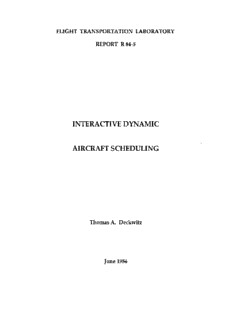
interactive dynamic aircraft scheduling PDF
Preview interactive dynamic aircraft scheduling
FLIGHT TRANSPORTATION LABORATORY REPORT R 84-5 INTERACTIVE DYNAMIC AIRCRAFT SCHEDULING Thomas A. Deckwitz June 1984 -3- ACKNOWLEDGEMENTS I am indebted to Professor Robert W Simpson as my advisor on this project for introducing me to the topic and his constant assistance and encouragement. I would also like to thank the followina special people for their friendship and support: the faculty and staff of the Flight Transportation Laboratory and the Wright Brothers' Wind Tunnel, the members of the MIT Ice Dance and Figure Skating clubs, my pairs skating partner, and my close friends in Seattle. I would like to dedicate this thesis to my parents and brother for their inspirational love and friendship and their unfailing support and encouragement. FLIGHT TRANSPORTATION LABORATORY REPORT R84-5 INTERACTIVE DYNAMIC AIRCRAFT SCHEDULING BY: THOMAS A. DECKWITZ FLIGHT TRANSPORTATION LABORATORY REPORT R84-5 INTERACTIVE DYNAMIC AIRCRAFT SCHEDULING by Thomas Anthony Deckwitz ABSTRACT Introducing recent advances in computer technology to improve aircraft scheduling is investigated. Incorpo- rating interactive graphics, modern database manipula- tion techniques, and decision support algorithms, the computer is proposed as a tool for the schedule develop- ment process, replacing present manual methods. A detailed set of graphics representations of sched- ule data are presented based on the sequence chart and station activity chart. The interactive manipulation of these displays by the scheduler results in an immediate appropriate update of the schedule database. Quick graph- ics response and automatic constraint violation alerts speed the search for feasible schedules. The execution of complex aircraft scheduling oper- ations by the proposed system is presented. Schedule dis- play and database structures are designed for implement- ation on computers with modern high resolution graphics and pointer directed list capabilities. Interactive Dynamic Aircraft Scheduling Table of Contents Page 1. INTRODUCTION 8 2. SYSTEM DESIGN AND DEFINITIONS 2.1 Design Scenario 11 2.2 Airlift Demand (Requests and TasKs) 12 2.3 Mission Generation 15 2.4 Mission Scheduling and Routing 18 2.5 Database General Design 21 2.6 Alternative Approachies to Scneauling Automation 3. GRAPRICS DUSP.AYS -1roduction 32 3. Station Activities Display35 3.3 Mission Seauence Display 47 3.4 Display Combinations & Additional Displays 58 3.5 Graphics Manipulation Tools 64 4. SCHEDULING OPERATIONS 4.1 Introduction 4.2 Mission Generation 77 4.3 Core Scheduling Functions 80 4.4 Basic Mission Scheduling 82 4.5 Positionino and SequencinQ E5 4.6 Scrieduling Times 96 4.7 Sliding 99 4.8 Scneduling Constraints 102 4.9 Scheduling Examples 109 4.10 Scheduling Assistance through Automation 119 5. ADVANCED SCHEDULING TOPICS 5.1 Introduction 130 5.2 Proposed Decision Support Functions 130 5.3 Advanced Algorithms 132 5.4 Advanced Topics 134 6. CONCLUSIONS 136 Interactive Dynamic Aircraft Scheduling List of Figures FIGURE PACE 2.2.1 Airlift Request Time WIndow 13 2.3.1 Single Mission from Multiple Requests 17 2.3.2 Multiple Missions from a Single Request 19 2.5.1 Scneduling Datanase Structures 24 2.5.2 Mission Database Structures 26 2.5.3 Station Database Structures 27 Basic Station Activity DLsplay Format 37 3.2.2 Station Activity Display Showing Constraints 37 3.2.3 Station Activfty Display Alignment Formats 3.2.4 WIde Time Band Station Displays 41 3.2.5 Narrower Time Band Station Schedules 42 3.2.6 Detailed Schedule of Station Operations 43 3.2.7 Multistation Display with Time Windows Highlighted 45 3.2.8 Electronic Picture of a Multistation Display 46 3.3.1 Aircraft Mission Sequence Display 49 3.3.2 Large Mission Sequence Display 51 3.3.3 Detailed Mission Sequence Display 52 List of Figures (continued) FIGURE pAi 3.3.4 Detailea Mission Sequence Dliplay wit Loa igr Time: Activities Times and Fla; DisplayveC 3.3.6 Detailed Mission sequence Display with Time Wincrow57 3.4.: Aircraft Information Overlay E. 3.4.2 Station Information Overlay 6 Mission Informat!on Overlay 6- 3.4.4 Nestea Mission Information Overlays Tne M-louse 352 Arrow-sriaped Positior iooicator 7 3.5.3 Selecticn Pectangle Generation 75 3 Port WinOow Locations 72 3.5.5 Opened Port Window 74 4.5.1 Positioning Flight Illustration 67 4.5.2 Positioning and Sequencing 4.5.3 Schedule Improvement through Sequencing and Positioning 89 4.5.4 Scnedule Improvement through Sequencing 91 4.5.5 Example of Resequencing Scheduled Missions 93 List of Figures (continued> FIGURE PAGE 4.5.6 Mission Sequence Window 95 4.9.1 Sample Schleduling MiniUniverse 110 4.9.2 MiniUniverse Displays, Step 1 112 MiniUniverse Displays, Step 2 :12 L.9.3 4.9.4 MiniUniverse Displays, Step 3 112 4.9.5 MiniUniverse Displays, Step . 114. 4.9.6 MiniUniverse Displays, Step 5 114 4.9.7 MiniUniverse Displays, Step 6 114 4.9.8 MiniUniverse Displays, Step 7 116 4.9.9 MiniUniverse Displays, Step 8 116 4.9.10 MiniUniverse Displays, Step 9 116 4.9.11 Example of Aircraft Activity 118 4.9.12 Crew Constraint Violation 120 4.9.13 Rescrheduled Feasible Solution 121 4.9.14 Infeasible New Mission 122 _P_ 1 INTRODUCTION Scheduling plays a central role in airline and air- lift planning and operations. No operational activities can be performed independently of the schedule and over- all cperational efficiency is determined by the specific scheduling of aircraft and crews. Improved scheduling ef- ficiency can have the same impact as addinc aircraft to the fleet. Scheduling is a complex function which routes aircraft, payloads, and crews in both time and space sub- ject to a multiplicity of operational constraints. Airlines and airlift operators have the opportunity to purchase extremely fuel efficient, advanced technology aircraft and most employ modern communications systems. Aircraft scheduling, however, is one function to which modern techniques and technologies have not been applied. Scheduling today is still done manually using wall charts, paper slips, reference books and colored pencils. The in- troduction of computerized scheduling processes has been limited, and schedule generation algorithms have not been able to solve even moderately sized scheduling problems. This report introduces the modern graphics computer as the sole tool necessary to handle the complexities of airline and airlift scheduling. The scheduling system uses graphics displays to represent scheduling information. I
Description: